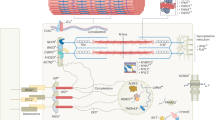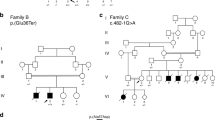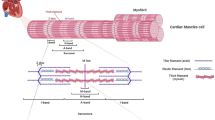Abstract
Pathogenic variants in genes related to channelopathy and cardiomyopathy are the most common cause of sudden unexplained cardiac death. However, few reports have investigated the frequency and/or spectrum of pathogenic variants in these genes in Korean sudden cardiac arrest survivors. This study aimed to investigate the causative genetic variants of cardiac-associated genes in Korean sudden cardiac arrest survivors. We performed exome sequencing followed by filtering and validation of variants in 100 genes related to channelopathy and cardiomyopathy in 19 Korean patients who survived sudden cardiac arrest. Five of the 19 patients (26.3%) had either a pathogenic variant or a likely pathogenic variant in MYBPC3 (n=1), MYH7 (n=1), RYR2 (n=2), or TNNT2 (n=1). All five variants were missense variants that have been reported previously in patients with channelopathies or cardiomyopathies. Furthermore, an additional 12 patients (63.2%) had more than one variant of uncertain significance. In conclusion, pathogenic or likely pathogenic variants in genes related to channelopathy and cardiomyopathy are not uncommon in Korean sudden cardiac arrest survivors and cardiomyopathy-related genes should be included in the molecular diagnosis of sudden cardiac arrest in Korea.
Similar content being viewed by others
Log in or create a free account to read this content
Gain free access to this article, as well as selected content from this journal and more on nature.com
or
References
Straus, S. M., Bleumink, G. S., Dieleman, J. P., van der Lei, J., Stricker, B. H. & Sturkenboom, M. C. The incidence of sudden cardiac death in the general population. J. Clin. Epidemiol. 57, 98–102 (2004).
Neubauer, J., Haas, C., Bartsch, C., Medeiros-Domingo, A. & Berger, W. Post-mortem whole-exome sequencing (WES) with a focus on cardiac disease-associated genes in five young sudden unexplained death (SUD) cases. Int. J. Legal Med. 130, 1011–1021 (2016).
Narula, N., Tester, D. J., Paulmichl, A., Maleszewski, J. J. & Ackerman, M. J. Post-mortem whole exome sequencing with gene-specific analysis for autopsy-negative sudden unexplained death in the young: a case series. Pediatr. Cardiol. 36, 768–778 (2015).
Saenen, J. B., Van Craenenbroeck, E. M., Proost, D., Marchau, F., Van Laer, L., Vrints, C. J. et al. Genetics of sudden cardiac death in the young. Clin. Genet. 88, 101–113 (2015).
Son, M. K., Ki, C. S., Park, S. J., Huh, J., Kim, J. S. & On, Y. K. Genetic mutation in Korean patients of sudden cardiac arrest as a surrogating marker of idiopathic ventricular arrhythmia. J. Korean Med. Sci. 28, 1021–1026 (2013).
Abecasis, G. R., Auton, A., Brooks, L. D., DePristo, M. A., Durbin, R. M., Handsaker, R. E. et al. An integrated map of genetic variation from 1092 human genomes. Nature 491, 56–65 (2012).
NHLBI Exome Sequencing Project (ESP) Exome Variant Server, NHLBI GO Exome Sequencing Project (ESP), Seattle, WA, USA. http://evs.gs.washington.edu/EVS/. (Accessed 1 May 2016).
Exome Aggregation Consortium (ExAC) Cambridge, MA, USA. http://exac.broadinstitute.org. (Accessed 1 May 2016).
Boczek, N. J., Gomez-Hurtado, N., Ye, D., Calvert, M. L., Tester, D. J., Kryshtal, D. O. et al. Spectrum and prevalence of CALM1-, CALM2-, and CALM3-encoded calmodulin variants in long QT syndrome and functional characterization of a novel long QT syndrome-associated calmodulin missense variant, E141G. Circ. Cardiovasc. Genet. 9, 136–146 (2016).
The Human Protein Atalas (2016). http://www.proteinatlas.org. (Accessed 15 June 2016).
Richards, S., Aziz, N., Bale, S., Bick, D., Das, S., Gastier-Foster, J. et al. Standards and guidelines for the interpretation of sequence variants: a joint consensus recommendation of the American College of Medical Genetics and Genomics and the Association for Molecular Pathology. Genet. Med. 17, 405–424 (2015).
Korean Reference Genome Database (KRGDB) Cheongju-si, Chungcheongbuk-do, Korea http://152.99.75.168/KRGDB. (Accessed 1 May 2016).
Behr, E. R., Dalageorgou, C., Christiansen, M., Syrris, P., Hughes, S., Tome Esteban, M. T. et al. Sudden arrhythmic death syndrome: familial evaluation identifies inheritable heart disease in the majority of families. Eur. Heart J. 29, 1670–1680 (2008).
Tan, H. L., Hofman, N., van Langen, I. M., van der Wal, A. C. & Wilde, A. A. Sudden unexplained death: heritability and diagnostic yield of cardiological and genetic examination in surviving relatives. Circulation 112, 207–213 (2005).
Stattin, E. L., Westin, I. M., Cederquist, K., Jonasson, J., Jonsson, B. A., Morner, S. et al. Genetic screening in sudden cardiac death in the young can save future lives. Int. J. Legal Med. 130, 59–66 (2016).
Tester, D. J., Medeiros-Domingo, A., Will, M. L., Haglund, C. M. & Ackerman, M. J. Cardiac channel molecular autopsy: insights from 173 consecutive cases of autopsy-negative sudden unexplained death referred for postmortem genetic testing. Mayo Clin. Proc. 87, 524–539 (2012).
Hata, Y., Kinoshita, K., Mizumaki, K., Yamaguchi, Y., Hirono, K., Ichida, F. et al. Postmortem genetic analysis of sudden unexplained death syndrome under 50 years of age: a next-generation sequencing study. Heart Rhythm 13, 1544–1551 (2016).
Maron, B. J., Olivotto, I., Spirito, P., Casey, S. A., Bellone, P., Gohman, T. E. et al. Epidemiology of hypertrophic cardiomyopathy-related death: revisited in a large non-referral-based patient population. Circulation 102, 858–864 (2000).
Gottschalk, B. H., Anselm, D. D., Brugada, J., Brugada, P., Wilde, A. A., Chiale, P. A. et al. Expert cardiologists cannot distinguish between Brugada phenocopy and Brugada syndrome electrocardiogram patterns. Europace 18, 1095–1100 (2016).
Morita, H., Rehm, H. L., Menesses, A., McDonough, B., Roberts, A. E., Kucherlapati, R. et al. Shared genetic causes of cardiac hypertrophy in children and adults. N. Engl. J. Med. 358, 1899–1908 (2008).
Seidman, J. G. & Seidman, C. The genetic basis for cardiomyopathy: from mutation identification to mechanistic paradigms. Cell 104, 557–567 (2001).
Albert, C. M., MacRae, C. A., Chasman, D. I., VanDenburgh, M., Buring, J. E., Manson, J. E. et al. Common variants in cardiac ion channel genes are associated with sudden cardiac death. Circ. Arrhythm. Electrophysiol. 3, 222–229 (2010).
Ackerman, M. J., Priori, S. G., Willems, S., Berul, C., Brugada, R., Calkins, H. et al. HRS/EHRA expert consensus statement on the state of genetic testing for the channelopathies and cardiomyopathies: this document was developed as a partnership between the Heart Rhythm Society (HRS) and the European Heart Rhythm Association (EHRA). Europace 13, 1077–1109 (2011).
Page, S. P., Kounas, S., Syrris, P., Christiansen, M., Frank-Hansen, R., Andersen, P. S. et al. Cardiac myosin binding protein-C mutations in families with hypertrophic cardiomyopathy: disease expression in relation to age, gender, and long term outcome. Circ. Cardiovasc. Genet. 5, 156–166 (2012).
Minikel, E. V., Vallabh, S. M., Lek, M., Estrada, K., Samocha, K. E., Sathirapongsasuti, J. F. et al. Quantifying prion disease penetrance using large population control cohorts. Sci. Transl. Med. 8, 322ra329 (2016).
Lek, M., Karczewski, K. J., Minikel, E. V., Samocha, K. E., Banks, E., Fennell, T. et al. Analysis of protein-coding genetic variation in 60706 humans. Nature 536, 285–291 (2016).
Yang, H. J., Kim, G. W., Kim, H., Cho, J. S., Rho, T. H., Yoon, H. D. et al. Epidemiology and outcomes in out-of-hospital cardiac arrest: a report from the NEDIS-based cardiac arrest registry in Korea. J. Korean Med. Sci. 30, 95–103 (2015).
Acknowledgements
This study was supported by Samsung Biomedical Research Institute grants (SMO1161371 and SMX1161381).
Author information
Authors and Affiliations
Corresponding authors
Ethics declarations
Competing interests
The authors declare no conflict of Interest.
Additional information
Supplementary Information accompanies the paper on Journal of Human Genetics website
Rights and permissions
About this article
Cite this article
Song, J., Kang, JS., Kim, YE. et al. Identification of pathogenic variants in genes related to channelopathy and cardiomyopathy in Korean sudden cardiac arrest survivors. J Hum Genet 62, 615–620 (2017). https://doi.org/10.1038/jhg.2017.8
Received:
Revised:
Accepted:
Published:
Issue date:
DOI: https://doi.org/10.1038/jhg.2017.8
This article is cited by
-
Concealed cardiomyopathy as an emerging cause of sudden cardiac arrest and sudden cardiac death
Nature Cardiovascular Research (2024)
-
Exploring TTN variants as genetic insights into cardiomyopathy pathogenesis and potential emerging clues to molecular mechanisms in cardiomyopathies
Scientific Reports (2024)
-
Unexplained cardiac arrest: a tale of conflicting interpretations of KCNQ1 genetic test results
Clinical Research in Cardiology (2018)



